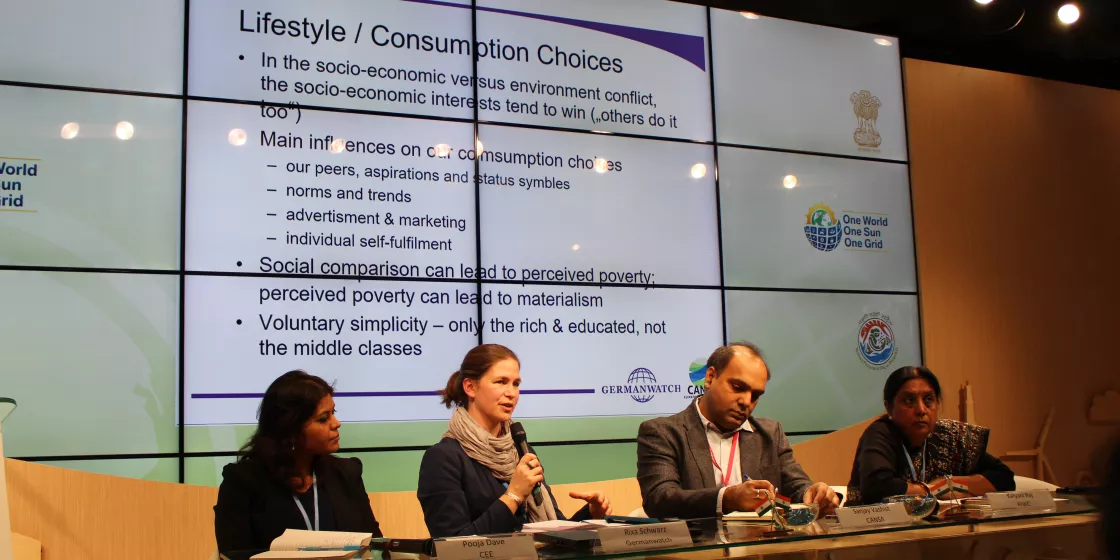The role sustainable lifestyles can play in achieving a paradigm shift to sustainability is acknowledged in both the Sustainable Development Goals and the Paris Agreement of 2015. They can be defined as “responsible living with our total surrounding and ourselves”, thus including aspects like global equity (see previous blogpost). Nevertheless, the vast majority of scientific literature focuses on ecological sustainability. To enable comparisons at a manageable scope, for this article we focus on environmental impacts.
Sustainable lifestyles in different contexts
Sustainable lifestyles emerge in entirely different socio-economic and cultural circumstances in India and Germany. Urban middle classes in both countries explore very different practices. The comparison of the most relevant and representative sectors for ecological sustainable lifestyles (such as building, food, and mobility) shows how the Indian mind-set is rather tuned towards efficient resources utilisation than the German one. The Indian middle class already runs the collaborative and sharing economy that Germany currently seeks to build through car sharing, the library of things, and plenty other initiatives. These, however only scratch the surface of the deeply embedded values of sharing and collaboration in India. Germany, on the other hand, has an advantage in technologies such as renewable energy, Germans practices waste management (yet to improve) and has the better (yet even more to improve) public transportation systems.
The challenge of modernizing traditional eco-friendly mind-sets in India
The Indian ecological footprint is way smaller than the German (1.1 global hectares compared to 5.1 global hectares in 2014, National Footprint Accounts 2018 edition (Data Year 2014)). Nevertheless, on a global scale it is important that India leapfrogs the western consumption patterns for which Germany is such an excellent bad example. The CANSA and Germanwatch study included ten suggestions for sustainable practices for both countries. These build on a mix of the most efficient individual reduction measures and measures that appear fitting for the two countries respectively.
For India, many of the suggestions include sticking to good or making smarter choices. Therefore, it is crucial that the urban middle class don’t follow unsustainable western ways of life but instead, when aspiring to “modernize” habits, do so in a “better” way than e.g. Germany, by still sticking to traditional eco-friendly mind-sets. This includes for instance a vegetable-based, seasonal and regional cuisine or an efficient resource use through sharing. The rising population share that is able to afford “throwaway” fashion and consumption goods, flights, bigger apartments, and other “western-model” lifestyle items, is a possible indicator for increased economic wealth. These people have the opportunity to definitely fulfil their basic consumption needs and many are moving out of poverty. Therefore, it is important that awareness is being raised in those societal classes, so that unsustainable western lifestyle behaviours aren’t part of a life that is worth pursuing. Instead, it is “true luxury” to stay sustainable despite other options. This can also be achieved by using public transports, eco-tourism and renewable energy. Modernising the Indian lifestyle patterns that per se are ecologically sustainable is the challenge of the hour. How can urban middle classes in India be convinced to skip non-veg fast food for a healthier veg slow-food culture? How can the use of sunlight for drying clothes in narrow dusty urban settings be modernised?
Resource-intensive living in Germany
The same accounts for the German urban middle class with the difference that the habit of sustainable lifestyle is not anymore part of a current way of thinking. Traditional, often sustainable, lifestyle patterns have been replaced by resource-intensive living. For many citizens in Germany, sustainable living has to be learnt from the very beginning. Therefore, bigger changes have to be made! Among these are on the one hand transitions, as to renewable electricity, organic products and energy efficient devices, which mainly require some investment. On the other hand, there is a need to change habits – that’s probably harder. This includes avoiding flight and car travels and instead using public transportation, switching to more seasonal and less meat- and dairy-containing diets, reducing living space or even working time and by consequence income and consumption. Interestingly, the German discourse has not yet switched from the efforts that these transformations require towards the far larger gains that sustainable lifestyles involve. A healthier, more social life is a happier life.
Increasing the political handprint
Certain elements remain, however, that cannot be solved by individuals due to a lack of necessary policy frameworks, for example regarding public transport. By consequence, a truly sustainable lifestyle only becomes possible with a supportive framework, set by product design, availability of sustainable products and services for a fair price or even regulations. Here, everyone can exert leverage through increasing their political handprint by engaging in society.





